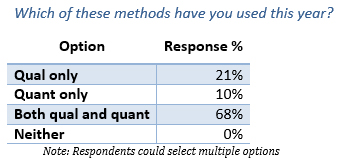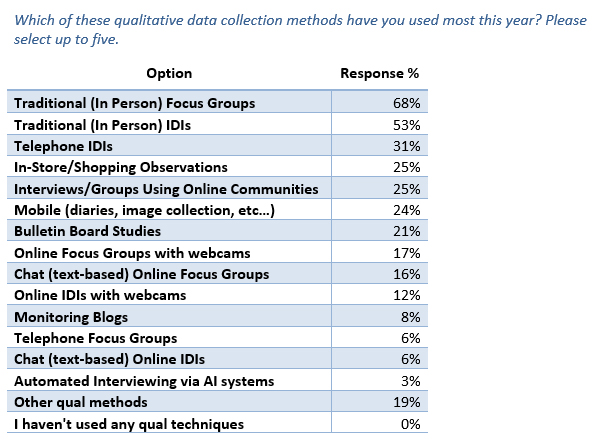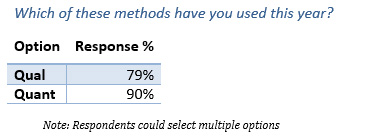I’m just about to start analyzing my section of the most recent GreenBook Research Industry Trends Report, but before I do I wanted to share again some of the findings from the last report. The GreenBook team conducted a global survey of 2,087 researchers.
When it came to methods that the respondents used in 2015, 9 out of 10 used quantitative research methods, while just under 8 out of 10 used qualitative methods.
The age of the pure “qualie” or “quant” is over. Most researchers surveyed (68%) have used both methods in the past year, though pure qualitative researchers outnumbered pure quantitative researchers 2 to 1: 21% of researchers surveyed had conducted only qualitative research, compared to 10% who had conducted only qualitative research.

Despite many online methodologies, qualitative research – unlike quantitative research – is primarily a synchronous, person-to-person phenomenon. Respondents were asked to identify the research methods they use the most (up to five methods per respondent). The top four methods are focus groups (a key method of 68% of qualitative researchers in the past year), in-person In Depth Interviews (53% have used IDIs significantly), telephone IDIs (31%), and in-store observations (25%). Asynchronous, online interactions range in popularity from interviews using online communities (25%), to mobile studies (24%) and bulletin-board studies (21%).
Only 8% used blog monitoring as one of their go-to qualitative methods, which is a surprise given its ability to be conducted passively and with no external costs outside the researchers’ time.

Quantitative, in stark contrast to qualitative, is dominated by impersonal, asynchronous automated methods: 88% of those researchers who have done quantitative research include online surveys in their Top 5, followed by 44% with mobile surveys. (Postal mail and IVR are not widely used: 11% cited mail surveys, and just 4% have used IVR surveys.) Traditional CATI (Computer-Assisted Telephone Interviewing) is a prime method of 39% of quantitative researchers.
Personal forms of quantitative research are still used, despite being supplanted by online techniques: 32% of quantitative researchers have used face-to-face interviews as a primary method, and 24% have used CAPI (Computer-Assisted Personal Interviewing).

You can download the GRIT report from here. Doing so will also make sure you are notified as soon as the new report is released.
